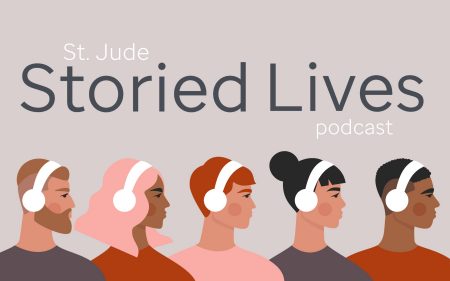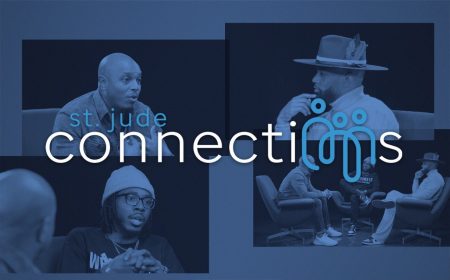
Foundation in Kenya collaborates with St. Jude to help more kids with cancer live
One cancer patient lost his hearing but found his purpose

March 28, 2024 • 5 min

When Sidney Chahonyo was 7, he got such a bad case of the mumps it almost killed him.
Doctors in his native Kenya saw a few symptoms and assumed it was malaria, he said. A bad reaction to the medicine left Chahonyo deaf in his left ear.
That’s probably why he didn’t notice at 19 ― fresh out of high school with a scholarship to study aeronautical engineering in the U.S. and a dream to build planes ― that he started asking people to repeat themselves. His family mentioned it and often said the TV was a little loud.
Chahonyo decided he’d better get his hearing checked. Maybe it was thick ear wax, but he’d already had other symptoms that wouldn’t go away. Pain in the back of his head that wasn’t quite a headache. A runny nose, occasional nose bleeds. Then the headaches got worse and the nosebleeds more frequent.
Doctors told him it had to do with his sinuses. After going to see multiple doctors with no relief, Chahonyo finally saw a specialist who said he was almost certain he knew what it was. But Chahonyo would need a few more tests to confirm.
Diagnosis delivered

Chahonyo was with his dad when the specialist sat them down for the results. This young man with big ambitions to study abroad had cancer of the post-nasal space ― the spot at the back of the nose that connects the nose and throat. There was a growth, increasing in size, and that’s why Chahonyo was struggling to hear in his right ear.
Chahonyo’s mind raced. He didn’t think much about what cancer meant for him. He worried about his five sisters, his mother and father. Chahonyo is the baby of the family and the only boy.
“And then I glanced over at my dad, and I saw he was balancing tears in his eyes,” he said. “And this is a guy who had been a pillar of strength.”
It was the first time he’d ever seen his father vulnerable. Chahonyo and his dad broke the news to the rest of the family. He doesn’t remember many details, just that they had to call because some of his sisters weren’t in the country.
“I remember hearing the word cancer, and I don’t remember much else from that day,” he said.
From oncology care to caring for others with cancer

What Chahonyo does remember is that the oncologist somehow gave him peace.
“From the very first appointment we had, he was very positive,” he said. “He was very hopeful. And he was giving me very many resources, you know, the support groups. He was like, this type of cancer is common in East Africa. And, you know, I have a couple of people who I’ve treated who have gone through it.”
Surgery wasn’t an option because of where the cancer was. So, Chahonyo underwent radiation therapy and then chemotherapy over 10 months. He was scheduled for six rounds of chemotherapy, he said, but after the fifth, tests showed no evidence of disease.
After his treatment in 2004, Chahonyo looked for ways to give back. He went to the national hospital and volunteered in the pediatric oncology ward five days a week for six months. A woman from Hope for Cancer Kids ― a non-profit organization dedicated to providing support, resources, and hope to families affected by childhood cancer in Kenya ― took notice.
Within a week, Chahonyo had been unanimously voted in as chairman of the organization’s board. And this year, he became the executive director of the organization, which raises money to support children from low-income backgrounds who can’t afford cancer treatment by paying insurance premiums through the country’s national hospital insurance fund. The non-profit pays premiums for nearly 400 kids a month, and provides psychosocial support, therapy and advocacy as well.

In 2021, Hope for Cancer Kids began a partnership with ALSAC, the fundraising and awareness organization for St. Jude Children’s Research Hospital, to learn fundraising best practices so the organization can identify and help treat more children with cancer in Kenya.
Those fundraising efforts will help with a pilot transportation program to help more children get to appointments to continue treatment and fund a care home where families can stay for longer periods of time without having to worry about food and accommodations.
Children with cancer in Kenya are often diagnosed with advanced-stage disease, Chahonyo said. Families often try traditional healers or the church first. And hospitals at the most local level don’t often suspect cancer so children are treated for something else, he explained. According to the Kenya Childhood Cancer Trust, the survival rate for pediatric cancer in the country is close to 30 percent.
Families travel long distances for treatment because there are few hospitals with comprehensive cancer care in the country. Children may not see their siblings or go to school for long periods of time, Chahonyo said. A cancer diagnosis can push families from poverty to extreme poverty, forcing them to sell land or borrow money.
“Some of them say, ‘I’ve called all my relatives. They don’t even pick (up) my calls anymore. Every time I come to Nairobi, I’m begging for a place to stay. I’m begging for, you know, food to eat,’” he said.
Chahonyo has deep compassion for children undergoing treatment. He understands the side effects and the suffering. Radiation therapy took away his own ability to taste, and it still isn’t back 100 percent
years later. He remembers the dry mouth and the incessant vomiting — the time he lost 20 pounds because he couldn’t keep anything down. He recalls how painful it was to swallow water and even to yawn.
And how he lost even more of his hearing. He needs a hearing aid to communicate effectively, and doctors say one day his hearing may disappear altogether.

But Chahonyo also knows the psychological effects on the family — the mental strain of worrying about money and the loss of friendships. He wants to make sure families of children with cancer in Kenya never feel alone in the journey, and to know that Hope for Cancer Kids will be the constant in their lives when they need it most.
“I’m helping someone who has gone through something similar, making their journey a bit easier,” he said. “… I keep telling everyone God saved me for a purpose, and I feel like this is the purpose that I was supposed to live.”
For more information about Hope for Cancer Kids in Kenya, visit https://hope4cancerkids.org.
It is estimated that more than 400,000 children worldwide develop cancer every year, and nearly half of them are never diagnosed. In many countries, 4 in 5 children won’t survive cancer, largely due to the lack of access to quality care. St. Jude Children’s Research Hospital believes children all over the world deserve the same chance at survival and is working with healthcare institutions and foundations across the globe to help make that dream a reality.








